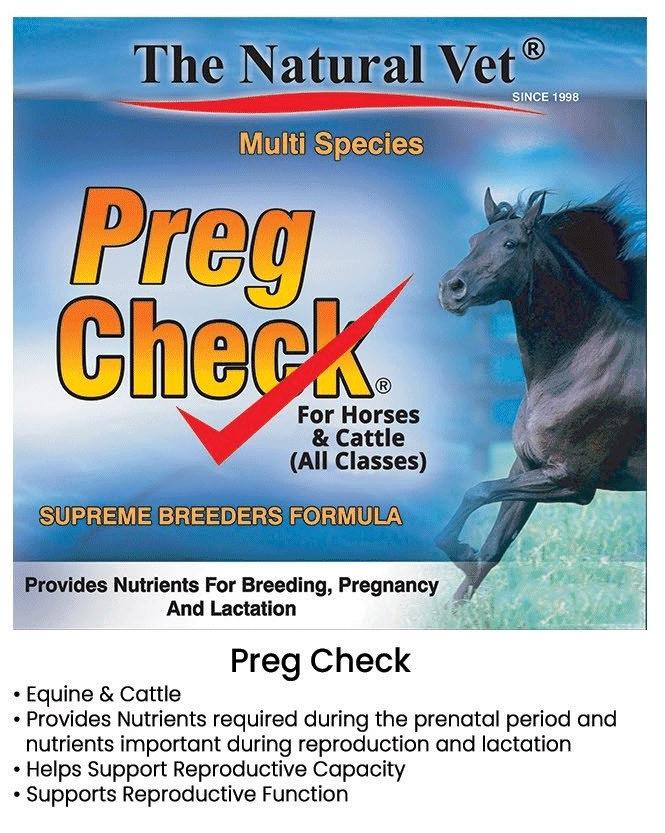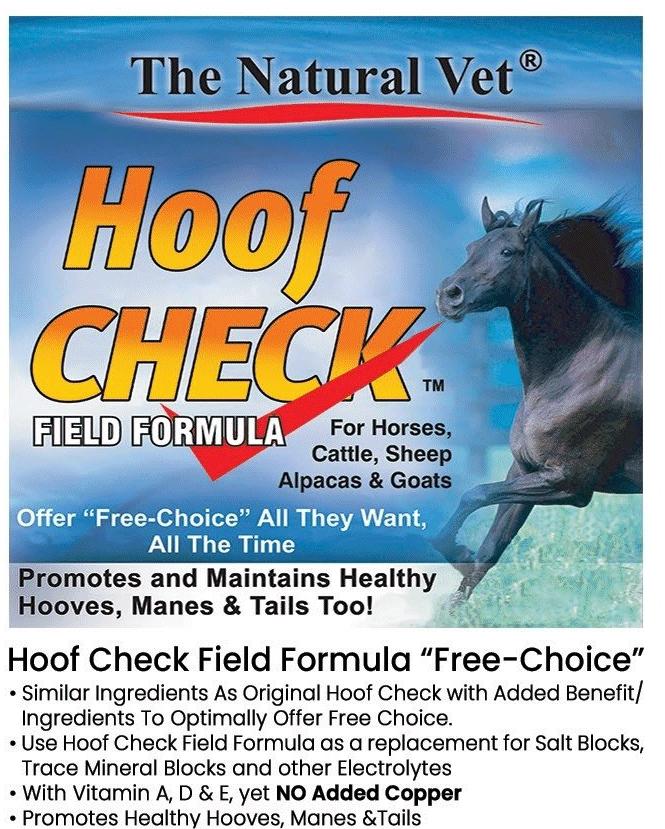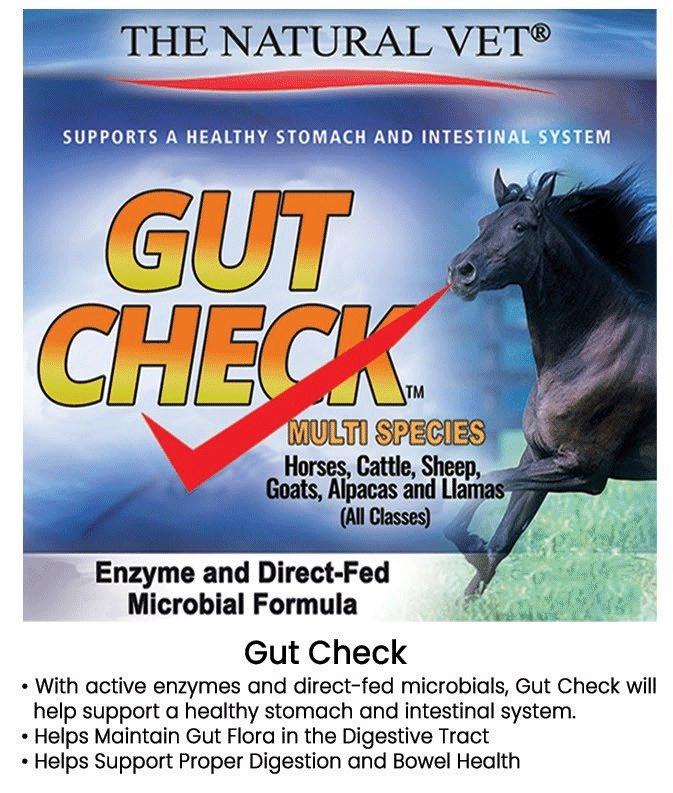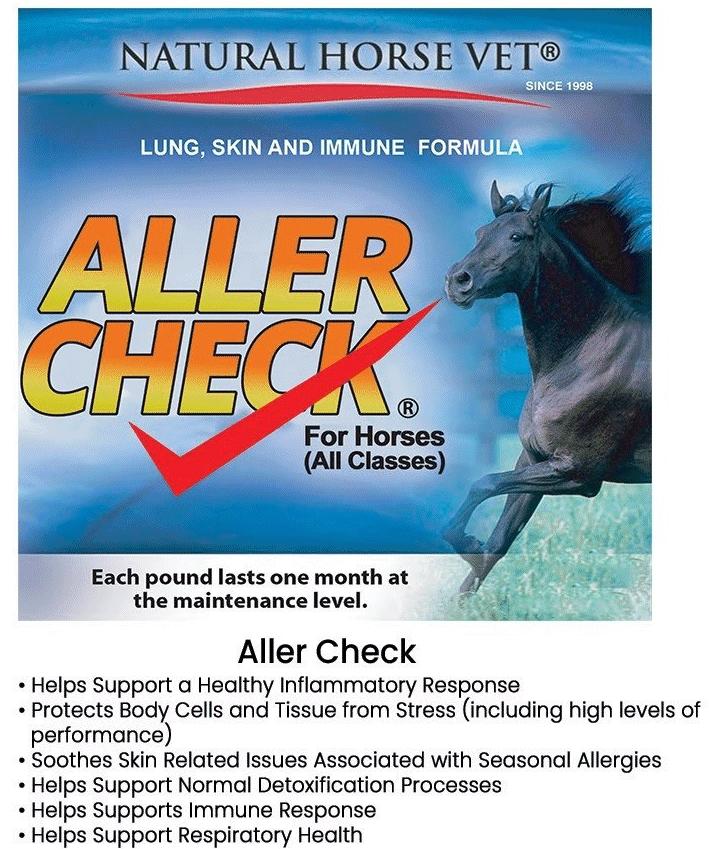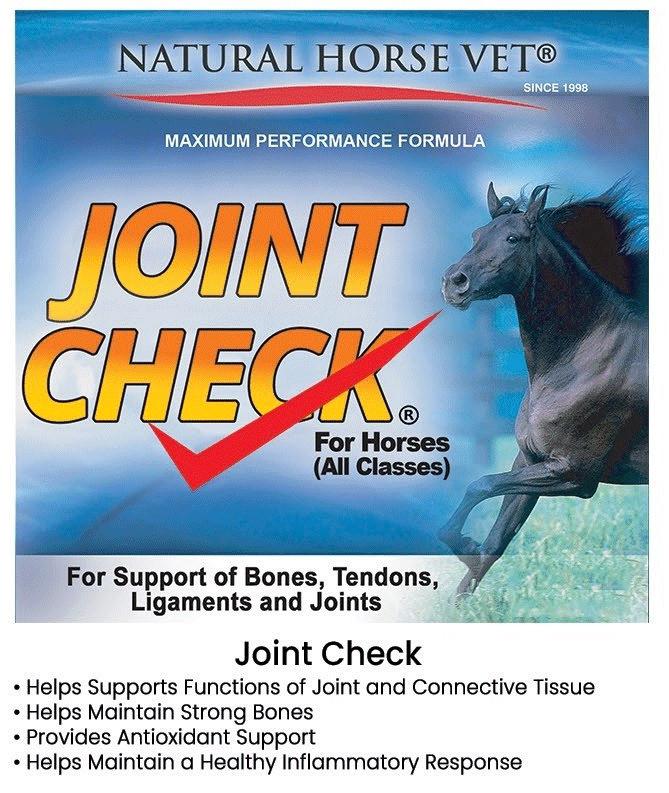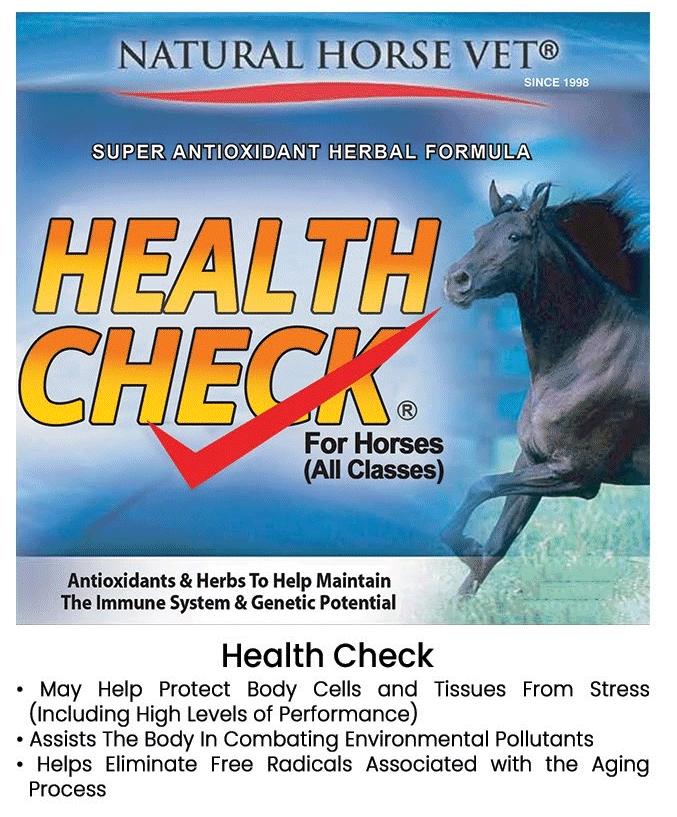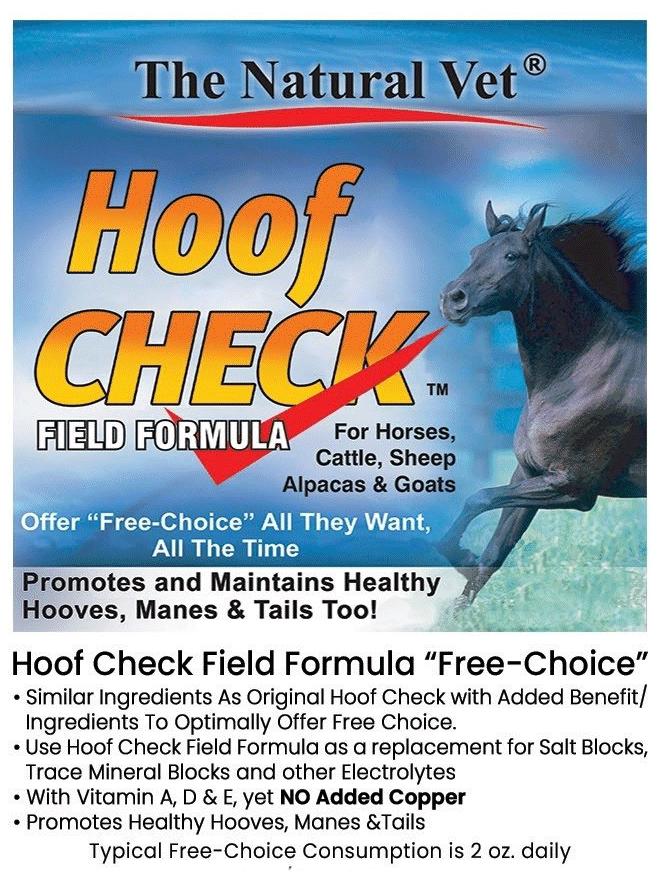
21 minute read
Perfect Pastures
Access to Needed Nutrients
By Dan Moore, The Natural Vet®
Advertisement
Grass Muzzles for pasture horses - that’s crazy!
Or is it? Grass muzzles are a hot item these days. I see them at almost every equine event I attend. Truthfully, I almost laughed the first time I saw one. Then I thought to myself “that is a great idea,” many horse owners today really need them. But why?
For thousands of years wild horses have lived on grass alone and typically they ate all they wanted. There was no one to stop them, turn them out for only a few hours at a time or worse yet MUZZLE them. Today, colic, allergies, metabolic issues, laminitis, hoof and other health issues are often associated with eating too much grass.
What is different about today’s grass or perhaps what is different about the horse? Obviously a lot has changed! If we truly look at the way it was and “mimic” what’s natural, perhaps we can have healthier horses and avoid a lot of problems.
Today’s species of grasses are totally different from the past. Most horses today on pasture only have one or two varieties of grass - usually timothy, orchard grass with some degree of clover and fescue. In the wild, they had access to vast areas of grass and abundant species. Equally important was access to other plants and herbs. Today they eat what they have access to in the spaces we confine them to. Most species of grass (and even grain) today are genetically modified - a controversy and discussion all in itself. By being able to “pick and choose” what they needed, horses received a balance of nutrients.
For instance, as I am sure you know, most horses will chew on tree bark. Of course it is bad for the trees - totally inconsequential in the wilderness, but in the back yard pasture, chewed dead trees look awful! Simple sugars called polysaccharides and amino acids like methionine and perhaps tannins are probably what they are after by eating the trees. Regardless, if methionine is supplemented most horses have better hooves. Supplementing simple poly saccharide sugars (not refined complex table sugar or syrup) will often help the gut (sometimes stop cribbing and help ulcers, too) - the gut being the source of almost all problems in a horse.
One such simple sugar in particular is Arabinogalactan, obtained from the Western Larch tree. Another is Mannosefrom the Aloe plant. The Native American Indians and “grandmas” everywhere have used these substances for centuries. In other parts of the world they may have used Noni fruit or Pomegranate or whatever was native to the area - and if the horses that were there had access to them, be assured they ate the bark, fruit (or whatever) too!
This is one of the reasons supplements are so important today - horses just can’t get all they need from the typical diets we give them, and the one or two species of grass they graze just doesn’t provide all they may need. There are most likely many ingredients or micronutrients that we have not yet discovered. I believe we will someday classify polysaccharides as “ESSENTIAL” polysaccharides, just like there are essential amino acids, and essential fatty acids now.
The need for the essential fatty acids like Omega 3, 6 and 9 are beginning to be more recognized by horse owners today. IN the wild, horses can pick and choose seeds and grass heads from various grasses and plants to get the fatty acids they need - in our care they take what we give them - unfortunately, until recently they have received very little. For the most part, they just receive sugars (like from corn and molasses), which, as we know, turns to fat but are not essential fatty acids.
Today high fat is “in” but again we must be careful. The easy thing to do is buy cheap fat like REFINED or partially hydrogenated oils (corn oil for instance). The problem with any refined oil is that all the “goody” is filtered out and sold for other purposes. Hydrogenated oils are more stable and less likely to spoils or go rancid, which is why they are used in almost every snack food, but they actually harden and damage cells within the body ad make tissue less pliable. This can actually make a situation like insulin resistance or metabolic disease (which are often the clinical problems that trigger the need for fats to be supplemented in the first place) to be even more of a problem. “Hardened” cells don’t respond to insulin and other “metabolic reactions” like more pliable cells would. Over time “hydrogenation” causes premature aging because more and more insulin must be produced and the body’s cells become more and more damaged.
One of the main purposes of insulin is to regulate sugar. The grain we feed our horses (corn, especially, and molasses) and the “richer,” single variety grasses in our pastures (and snack foods for us) also cause more and more insulin to be secreted. With time, this causes “insulin resistance” - requiring more and more insulin to get the job done. The higher the resting insulin overall, the quicker all species age and subsequently die - period! High resting insulin is rarely detected because usually just blood glucose is checked. Simply relying on blood glucose (sugar) levels alone is not enough - sugar or blood glucose can be normal but resting insulin levels can be extremely elevated - even high enough to kill you or your horse.
Many horses (and people) are insulin resistant with high resting levels of insulin, but because the body is such a miraculous machine it is still keeping the sugar normal. Most fat and overweight “easy keepers” are insulin resistant. Certainly hypothyroid, Cushings, and chronic recurring laminitis or foundered horses fit this category as well. Lush green grass or stress (as in people) is often associated with, and generally what gets blamed for acute occurrences - but the underlying metabolic situation is usually at cause. Horses need good fats, not sugars!
By now it should be clear that except in a free wild range situation with thousands of acres, it is impossible to have a perfect pasture today - but there is a “next to perfect” answer to the perfect pasture question! A perfect pasture is one that has a bucket (free choice access) of natural salt and naturally sourced minerals hanging in it - AT ALL TIMES. And I stress NATURAL source here and at ALL times. Even white salt and most minerals are chemical, often other industry’s leftovers, full of heavy metals (lead, cadmium, arsenic, aluminum, mercury). And salt blocks are just simply useless because horses are not lickers - they can not get all of what they need from blocksperiod! They just can’t lick fast enough.
Once again - in the wild, horses have access to all types of salt and minerals where they can pick and choose and balance themselves as needed. Today we fortify the feeds with various minerals and fortify our pastures with fertilizer. The problem here is that we may actually be causing an imbalance of nutrition. Mineral supplements, though well intentioned, may give them too much of what they don’t need. Hoof supplements are especially bad for this - massive amounts often, chosen by man and based on an RDA (recommended daily allowance standard) that is 15 years old or more. Natural minerals and salt like colloidal minerals and sea salt (often from desert sources that used to be the ocean millions of years ago) contain other micronutrients as well, and are balanced by mother nature, not by man.
The confusing issue here is that if you compare mineral amounts to man-made products, natural sources often look like they contain very low levels. But what they do contain is so much more usable or bio-available that it packs a much greater, yet balanced punch! They literally contain every nutrient and mineral that was once in the “living oceans.” Often with manmade our horses over-consume what they don’t need while trying to get what they do need. AND, what they really need may not even be in the mix because man is not aware of itnatural is better!
Pasture horses must have access to loose salt and minerals at all times. If they don’t, they can colic, founder, abort and die almost without warning. It all comes back to the health of the horses’s gut. Any sudden change, as we well know, can be disastrous. Obvious concerns are getting too much grain or sudden exposure to lush green grass - but a weather change without free access to loose salt and minerals can be just as deadly to a pasture horse.
Grass is a living, breathing organism (it just breathes carbon dioxide rather than oxygen) and it changes hour to hour. If the grass “thinks” it is going to die or has less chance of survival, it conserves and prepares - just like we would. Conservation of water would be a likely action. Grass does this by actually drawing potassium up from the ground, and if the soil is heavily fertilized, it can draw a lot, because a major part of fertilizer is potassium. Potassium allows the plant to attract more water. This is good for farmers who sell hay and crops by the pound but bad for the actual nutritional value because the grass, crop or whatever, is mostly just water. Devastation can occur if horses, cattle or other creatures are exposed to too much potassium at one time.
If you are a cattleman, I am sure your are familiar with Grass Tetany and Milk Fever, and the sudden death associated with its occurrence. These were once thought to be magnesium and calcium deficiencies. We now know it is from high potassium forages and grasses. Similar situations causing abortions and gut problems often occur in horses. What happens is that the potassium spikes during cool, wet conditions and especially after long droughts followed by rainfall and rapid growth. Situations like frost and freezing are especially bad - have you ever had horse colic after a frost? Probably so--the reason is a sudden mineral change in the grass, not just frozen grass! During these times sodium, calcium and magnesium decrease, while potassium increases. This spike in potassium is often deadly. A major problem like this occurred in 2001 in the Midwest where reproductive losses occurred in thousands of horses, cattle, sheep and goats. This was severe in Kentucky as well. Often cattle were found dead just a few hours after frost and freezes. Mineral blocks just cannot provide the minerals fast enough for such rapid changes in weather. Free choice, loose salt and minerals must be available to pasture horses at all times if such problems are to be prevented!
It is also important to consider that since sodium (the Na part of NaCl, or salt) is so similar to potassium, horses often think they have enough sodium (but really have too much potassium) so they stop eating salt. This is especially so in the winter when they need it most. Force-feeding salt is a viable solution particularly in pregnant mares. This should be in addition to making it readily available free choice. (Always be sure to put any salt product near readily available water).
One further point is that fescue alone is usually blamed for abortions in mares when it is actually the fungus like organisms on the fescue that cause the problems. BUT again it is elevated potassium that generally makes these organisms more deadly! The bottom line here is that less fertilizer is better and fescue should be avoided for pregnant mares. It would also seem obvious to me to avoid hay that has been grown on heavily fertilized fieldsespecially for pregnant mares.
Now the big question is how can I make my field better if I can’t fertilize? The answer is to avoid the typical types of fertilizers - those that are salt based. Salt fertilizers are destroying our environment as well as our soils. Year after year of fertilizer use kills beneficial earthworms that oxygenate the soil with their tunnels. Lack of oxygen kills the soil just like it would us.
Fortunately, there are “time tested” ways to fertilize that are often even more economical and certainly more beneficial. Unfortunately because of all the “politics” involved, major universities seldom teach their use. One of the healthiest ways to make good pastures and again, often the most economical is to heavily lime your fields twice per year. Lime is Calcium Carbonate. Calcium keeps the soil basic rather than acid. Basic soil is healthy just as a more basic pH is healthier for people. Calcium in the form of lime is cheap and I promise if you have many weeds at all growing in your pasture, you need lime. Don’t expect immediate results however, because it takes time for the lime to be absorbed and utilized. But it will help tremendously over time.
While your pastures are improving, it is important to supplement the diet. Most horses I have found, at least in the eastern US, are calcium deficient. Typically, soils in the western United States contain more calcium - which is why the buffalo once flourished there and not in the east. Tremendous calcium is needed for the buffalo’s huge bones.
For many years now, ring neck pheasant have not grown in the southeastern United States either, simply because there is not enough calcium in the soil to support their egg shells. Most horses have plenty of phosphorus in their diets, so I don’t worry too much about balancing the calcium to phosphorous ratio. An exception would be older horses, which occasionally can use more phosphorus.
The answer to perfect pastures is simple - do not use fertilizer and if you do, use liquid, non-salt types, plenty of lime for the pasture and keep a bucket full of NATURAL salt and minerals readily available to your horses at all times! Consider the use of crude, unrefined, essential fatty acids because horses today just can’t get them naturally, and because they are so important to overall health.
One final suggestion: If your horse does not have access to grass, such as in the winter, or if the grass is poor, always supplement with Beta Carotene. Green grass generally provides plenty of Beta Carotene (vitamin A, by the way, is not enough) but hay provides hardly any. Beta Carotene is crucial for reproductive health, lactation, immune function and hundreds of other benefits. I believe it, too, will be considered “essential” in the future.
Tw o Gr eat Pro duc ts For Your “Less-T han-Per fec t-P astur e” H orses!
“All horses, especially those pastured horses, must have access to loose (preferably naturally sourced) salt and minerals at all times! In my humble opinion, RED CAL is the single most healthy thing you can give your horse to prevent problems. Just hang a bucket on a fence post and make sure there is always some in it.”
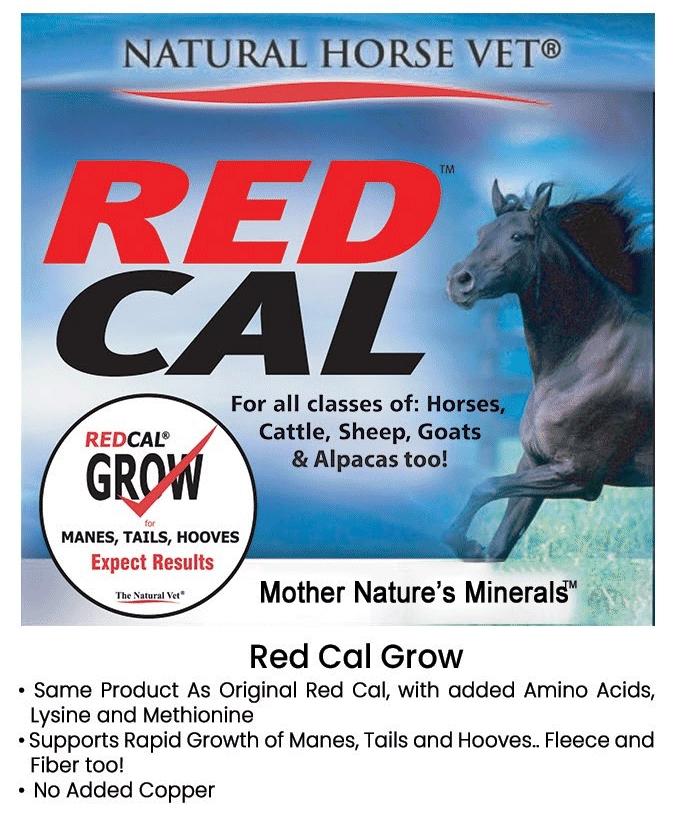
-Dan Moore, The Natural Vet®
Nutrihealth
A Radical Solution
By Dan Moore, The Natural Vet®
For horses, pets, and people, nutrition and preventative health has never been more important than today. Imagine 100 horses in a herd exposed to influenza, some will get sick and some won’t. Why? Imagine 100 people exposed to anthrax, some will get sick, some won’t. Why?
I know it is scary to think about either situation, but similar scenarios are actually occurring right now in each of our bodies. The battle is health versus sickness. This battle never stops. It is constantly raging and we are the effect of it. Or could we really be the cause of it? If everything were well and wonderful everyday, then I imagine we would be well and wonderful, but, I think that it goes without saying that that is impossible! Stress is a major cause of illness, but how does this relate to our horses?
than the disease, especially if the disease is very, very rare? And what if the disease were treatable anyway and what if I could prevent it with good nutrition including antioxidants? What longterm effects could these vaccinations have? I ask these seemingly ridiculous questions because I think our horses have changed for the worse since my 21 years in practice. I believe they are weaker today, less resistant than in the early 80’s and just seem to have much more cancer, colic, founder, pulmonary disease, allergies etc.
So I question: WHAT HAS CHANGED?
“We are vaccine free for almost four generations now and we very seldom get sick horses.”
First, let’s define a working definition of stress. My way to describe stress, right or wrong, is “the effect of something or someone you feel you have no control over.” Anybody stressed lately? Unfortunately for our equine friends stress is a part of life. Showing, trailering, training, breeding, it seems there is always stress in horses’ lives. But, since they ARE affected by us it is our responsibility to keep them “less stressed” or they will get sick.
Let’s face it, though, we can’t quit showing, performing, trailing and breeding, etc. I guess some of us could just be professional petters, myself included, but these guys really prefer to work right? Probably just keeping them in a stall and not letting them to perform or work is the most major stress of all. So, with reason, let’s assume we keep going about our normal business. But are there other ways we stress our horses without knowing it? I absolutely think that we inadvertently stress our animals everyday, and the bad thing is we do so with the best of intentions.
Take vaccinations for instance, are they really that important? Most folks in the “real world” would argue YES, but I have to ask myself, could the cure be worse
A good example of this change is EPM. Why after million of years does the horse suddenly have a problem with possum manure? I don’t claim to have the answers to this but I have some theories. Certainly we do vaccinate much more than when I first started practice. We didn’t even vaccinate for rabies then, but then one or two horses came down with it and whammo … millions vaccinated. The same was true for Encephalitis and Strangles and now West Nile and even EPM, with provisional vaccines, no less, that may or may not even work when all the facts are gathered.
Have you ever vaccinated a horse for influenza and it later came down with it? How about vaccinated for Strangles and in a few short weeks it was leaking pus all over the barn? How about, heaven forbid, Rhino and the mares later aborted. I have – plenty of times. In fact, so much so that now I don’t vaccinate at all. We have about 30 Rocky Mountain Horses and we are vaccine free for almost generations now – and we very seldom get sick horses. No more abortions after horse show exposure. No more strangles, knock on wood! Our horses are just healthier!
Another thing I don’t do is deworm every 2-3 months.. Foreign substances like deworming chemicals and vaccinations just confuse the bodies’ healing mechanisms to where it has no clue what is supposed to be part of the body and what is not. It seems to just start reacting to everything. Take for instance the allergy tests on those horses with hives. Every one of them I have seen the results on seem to come back allergic to everything. Like hay, grass, dust etc. – you know, those things you can’t keep horses away from anyway. The best you can do in most of these cases is wet the hay right? Anyone have a horse sensitive to flies? Come on, horses are supposed to live with flies, not break out in sores and hives. What has changed? in the first place. I don’t use flax oil in horses only because I find it difficult to maintain the freshness. Rancid or spoiled oil is worse. And heaven forbid if you know anyone using corn oil, alias syrup, please suggest they stop! For horses I prefer a mixture of soybean and coconut oil. Our brand is called H2Oil, Hoof and Health Oil. Despite what you read in the press, coconut is both good for both man and beast. My favorite grain to top dress it on is oats.
The answer to deworming, by the way, is to simply check to see if they even have worms before deworming. All horse don’t have worms – we check hundreds of samples in our office. TRUE, all horses are exposed to worms, but, guess what? SOME ARE RESISTANT, or so it seems! In my early years of practice we used to always check first with a fecal sample because we had to pass that nose tube and that was potentially risky business. That was a “known” risk, I believe an unknown risk is even worse. Could it be that overzealous use of pastes could be just as risky? Worse yet are daily dewormers! I have no doubt that some day we will have super worms that are resistant to everything! Daily dewormers are not helping. Paying for a colic surgery is a great marketing stategy, especially if it keeps you using drugs and chemicals, isn’t it?
I know I am stepping on toes here but it may be time to reevaluate. This is tough when one has blinders on and just follows the norm without question. I understand and I could be completely wrong, BUT….Understand too, that I used to make my living as a “conventional” veterinarian using vaccinations, steroids, antibiotics and other such routine stuff. How could I have made such a drastic change? Thank goodness mainstream is now changing too!
For example, small animal practitioners are being advised to no longer vaccinate just by the “calendar,” i.e., yearly, but to consider the individual needs and actual likelihood of exposure. True, this is very controversial, but a real step in the right direction. Such recommendations will be forthcoming for equines as well, but my concern is that all the fear about the “new diseases” will greatly hinder this coming. A major equine publication just last year quoted “Looming Disaster with Our Current Deworming Practices” citing such concerns as chemical toxicity and the resistance factor I already mentioned. But then another major equine magazine said garlic was potentially toxic because they didn’t know the difference between an onion and garlic! So, go figure!
Bottom line is, it is our responsibility, not the industry’s in general, to do what is right for our horse. Everybody has their own agenda. In the later Garlic article, by the way, if you questioned it, you were referred to a major university toxicology hotline. It cost $45 for a consultation. While you waited for the veterinarian, the recording attempted to sell you a book on Natural Toxins in horses. I paid the $45 for a search on garlic toxicity –never had they had a reported case, plus, with ALL their research material at hand, they could not find one substantiated reference to garlic toxicity –Onions, yes (5 pounds), Garlic, NO!
For your listening pleasure, you can hear my recorded conversation on our website at www.thenaturalhorsevet.net. The $45 was worth it and it did go to a good cause I am sure, but I didn’t buy the book. I apologize for being so sarcastic here but Horse and Rider just blew that one in my opinion. Such a shame for such a good magazine!
So we have talked about vaccinations and deworming –what about these “non toxic” chemicals? You know the kind for flies and such, that you, too, breathe each time you spray them or spot them on. Sure these substances are “nontoxic” but what about subtoxic? After all, “toxic” is the amount of the chemical or substance that is needed to kill an animal or person. What about the subtoxic effects that might increase viral and bacterial infections by weakening the immune system “function,” i.e. lowering the white blood cell count, slowing white blood cell movement, destroying the mechanisms the white blood cells use to locate and destroy virus and bacterial cells, etc.? What about lowering production of the essential immune system regulator interferon or weakening or damaging antibody production?
One such chemical on the market today is 65% permethrin. You can’t use any amount on you and you sure can’t use malathion, lindane or even furacin – that yellow stuff for wounds - but it is OK for equines! By the way, PLEASE read the label on furacin – it has carcinogenic warnings all over it. Again, I used to use it by the gallons. So please understand I am not being critical, I guess I am just trying desperately to spread the message that “if there is an alternative, find it and use it.” And if you can’t find it...Keep looking! Please...we as practitioners don’t heal anything, none of us do, the best we can do is trigger the body to heal itself. It is as simple as that!
The problem with so many drugs and chemicals is that they so badly confuse the body’s healing by taking over, leaving only another problem to deal with from the compounding effect of NEVER having been healed in the first place. I hope this makes sense and I hope you will help me keep looking.
Diets that we feed our horses are another major factor in preventative health. Our horses did not eat grain in the wild, especially so much corn. Why do we have to add so much molasses to their feeds? Perhaps because they don’t like the feed? Or is it because it is really not good for them? Corn, for instance, has the same glycemic index as sugar. In other words, a tablespoon of corn has the same effect as a tablespoon of sugar. Molasses essentially is a sugar. Just imagine the blood glucose rising after the first meal of the day. Now imagine the blood sugar crashing to a low level.
Herein lies the problem- a sugar low equals “starving” to the horses’ metabolism. The metabolic system does all it can to get the blood glucose back up. The pancreas, adrenals, thyroid, all kick in. These glands literally are worn out by the vicious cycle, day after day, of high and low sugar levels.
Imagine asking your horse to act while on a sugar low. This is probably the number one cause of moody and hyper horses. I also believe this daily metabolic stress is the reason we have so much founder and colic today. Even when a minor stress comes along they have no reserves left because of the weekened adrenals and thyroid.
What else can we do to tip the scale to the side of wellness? Use antioxidants! They are the scavengers of sickness, the buzzards that clean up all the messes in our bodies; the rustoleum that prevents the rust in the first place, or better yet, that which stops the rust dead in its tracks! The rust, or oxidation, is what turns the apple brown when you cut it in half. It is oxygen gone bad, free radicals bombarding everything it finds.
Consider Bug Check Today!
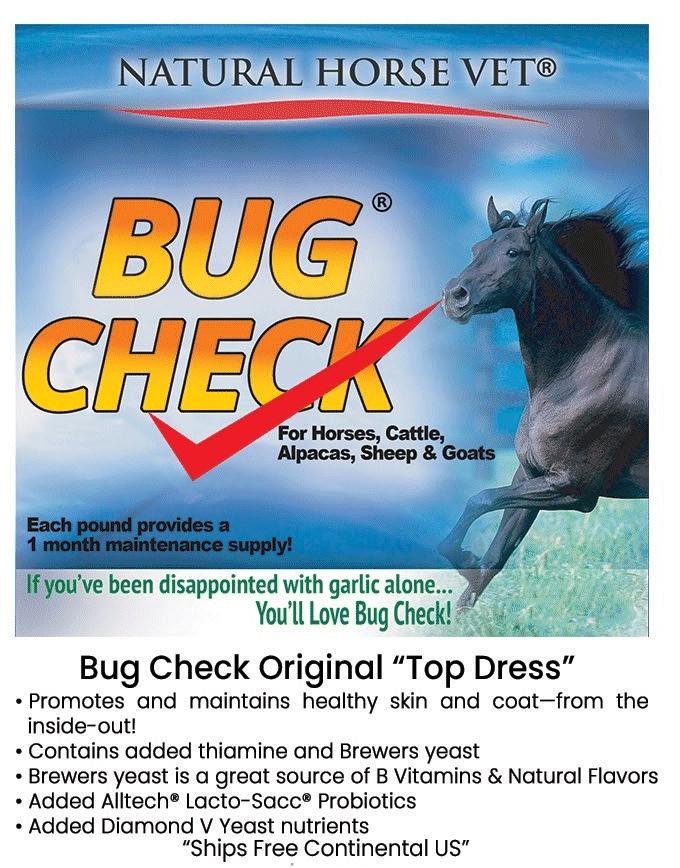
Bottom line, if you want your animal friends to live longer and healthier lives, give antioxidants daily and take them yourself. It’s already been proven that antioxidants are beneficial. It has been since the 60’s. Every day our animal friends, as well as ourselves, are bombarded with pollutants. We eat them. We drink them. We breathe them.
The weak links are the gut and the feet, hence colic or founder. This same scenario even happens to dogs and cats. Have you seen the amount of corn in pet foods lately? Based on the number of doughnut shops, bagel shops, and high fructose soda pop machines around, alot of people are destroying their “stress resistance” with carbohydrates and sugar, too.
The answer for people is 25 grams of protein first thing in the morning with fresh flax oil or virgin olive oil (two tablespoons). The answer for horses is a good oil top dressed on the grain which slows the absorption on the grain and prevents the high spiking sugar levels
Even horse feed (not to mention our food) has pesticides, herbicides, antibiotics, hormones, etc. in it! Water has chlorine, trihalomethanes, alum, lime, and potassium permanganates just to name a few! My goodness, just smell the air as you travel down the polluted highway. I believe you get my “drift”!
If I only had one thing that I could do to help tip the scale to wellness it would have to be to use the antioxidant and natural “antibiotic” garlic. It is an awesome antioxidant, a tremendous source of sulfur for the body and a tremendous bug powder when mixed with the a few other ingredients. Sulfur is one of the most basic substances needed to rejuvenate tissue.
Do you know that at one time garlic was used successfully to prevent polio? It was also found to be a more potent antibiotic than penicillin, ampicillin, doxycyline, streptomycin, and cephalexin- some of the very same drugs used to treat Anthrax. It was even effective against some strains of E. coli, staph and other micro organisms [Fitoterapia Vol 5, 1984].
Other sulfur-bearing antioxidants, Alpha lipoic acid, Nacetyl Cysteine, Taurine, and Vitamin C have been shown to elevate levels of Glutathione. This, too, is a potent antioxidant and also has been shown to counter the toxicity produced by anthrax [Molecular Medicine, November 1994; Immunopharmacology, January2000; Applied Environmental Microbiology, August 1979; Bill Sardi, Knowledge of Health].
And don’t forget Grapeseed Extract, one of the most potent antioxidants known to man.. Well, I guess if you are still reading this you are either ready to shoot me, you are saying, “yea,” or maybe “boy, that guy is nuts!” Regardless, I ask you one more thing… if you are not familiar with homeopathy, I suggest you please check it out. It, in it’s truest form, is the answer to our situation today. And yes, there are even remedies for symptoms of anthrax, smallpox, radiation exposure, plague, etc. Though there are new strains now the symptoms these diseases produce are nothing new. They were here last century and often treated successfully with homeopathic remedies, even then. I for one won’t be lining up for vaccination - but I will be doing everything I can to help my body help itself.
The correctly chosen homeopathic remedy simply triggers the body to do just that - heal itself. But it goes without saying that all healing depends upon good nutrition. If the body doesn’t have the nutrition it needs, it is like a car without the gas, it simply won’t run. What do you say… let’s keep running! See you at the races! Hope this helps!
Six Great Products for the Nutritional Health of Your Horse!
